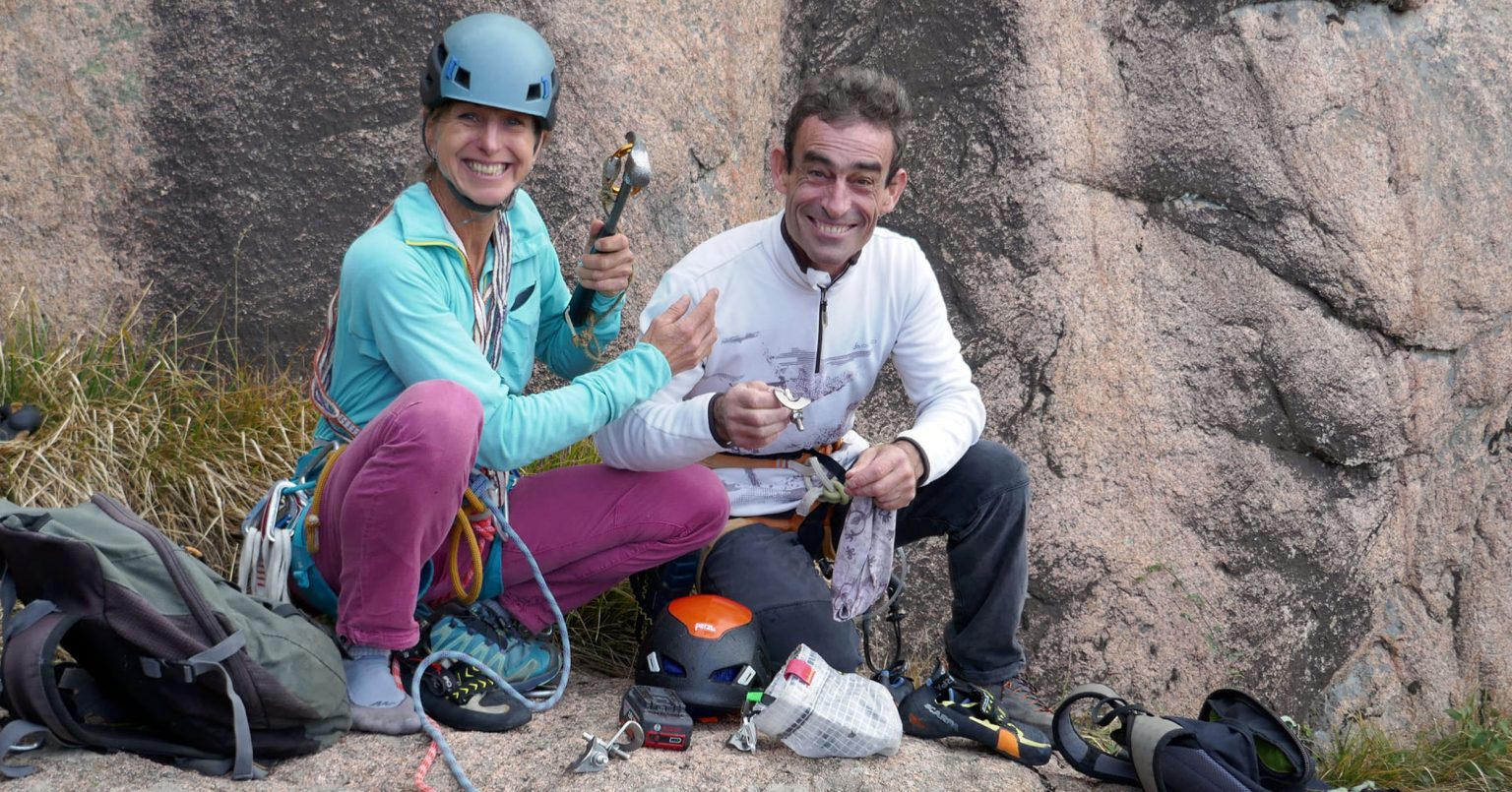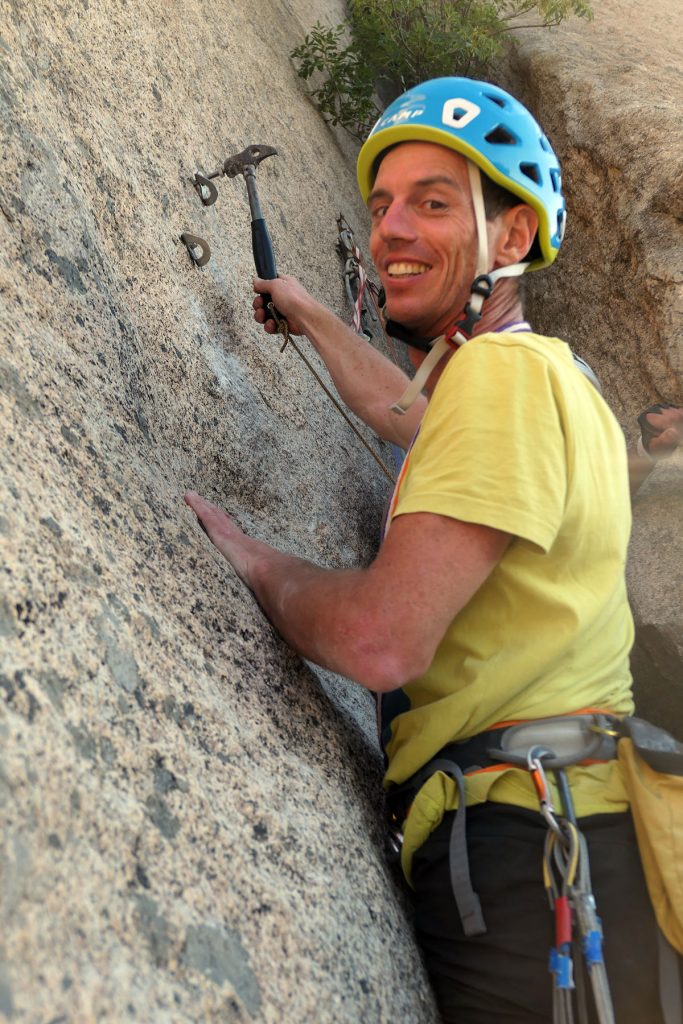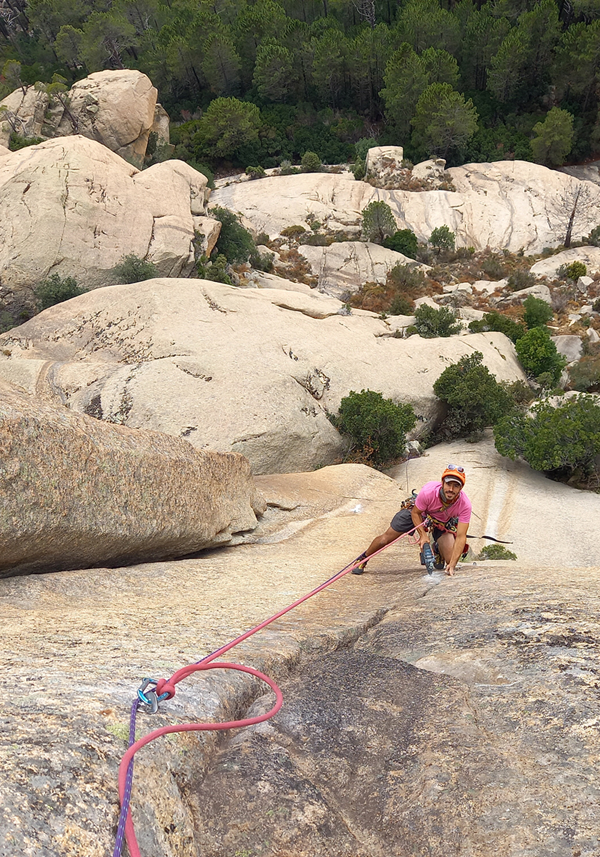The corsican bolting fund

Bolting and maintenance of Natural Climbing Sites in Corsica in 2021
(updated on 1/11/2021)
We have been publishing climbing guidebooks about Corsica since 2006. In addition to our objective of providing precise and reliable information to climbers, right from the outset we created a system that would generate a financial contribution to maintenance and development of crags and multi-pitch routes in Corsica. For many years, this was in the form of a partnership with the Corsican mountain league (FFME).
In 2018, this collaboration came to an end and a Route Bolting Fund funded by sales of our guidebooks took over.
Key figures about the Route Bolting Fund:
For the three guidebooks that we publish and distribute through our company Omega Roc, the following are allocated to the Route Bolting Fund:
– Falaise de Corse guidebook (2022 edition): 15% of the sale price, that is €5.70 per guidebook*
– Bavella-Corsica guidebook (2020 edition): 5% of the sale price, that is €1.75 per guidebook*
– Grandes voies de Corse guidebook (2021 edition): 10% of the sale price, that is €3.00 per guidebook*
In spite of the successive lockdowns and restrictions on movements in 2020 and 2021, which had a serious effect on guidebook sales and therefore on the amounts going into this fund, a significant budget remains, with €30,000 allocated to the Bolting Fund since 2018.
This budget has been used to buy the most durable bolting equipment available: expansion bolts and stainless steel hangers, galvanised glue-in bolts and various consumables. This equipment is provided to route bolters on request. These workers behind the scenes have kept up their efforts and continued to develop the island’s crags and multi-pitch routes. The new crags and routes are included in our guidebooks and/or on the OmegaRoc app.
For crags :
Approximately 1900 hangers, 2250 expansion bolts, 270 belays and 900 glue-in bolts have been distributed
– Development of 3 sectors that already existed: 3G, Suare, Trimbulacciu (Illusions perdues sector)
– Creation of 6 new sites or sectors: 3 Caves, Linea d’ombra, Ciuffatu, Saint Antoine le Toucan, Bonifatu la Vasque, Restonica l’Oratoire
– Maintenance work at 13 sites that already existed: Pietralba, Saint Antoine, Terre sacré, Tolla, Rupione, Pignu, Tipponu, Monte Canarincu, E torre, Petre scritte, Les Iles, Curriali, Bonifatu (bouldering sector)
– More than twenty bolters involved from all over Corsica: Adrien Boulon, Antoine Cesari, Camille Giammarchi, Carlos Ascensao, Christophe Sauvagnac, Flo Bertholle, Jeff Andreucci and several members of Corsica Roc, Guy Tomasini, Hervé Rondeau, Benoit Cagnard and Julien Queva (I Muntagnoli di Corti), Laurent Bertolotto, Marco Constant, Nico Nastorg, Pierrot Griscelli, Sam Bourcey, Timo Leonetti, Vlado Cviklinski, Vincent Mosimann
For multi-pitch routes:
Approximately 2100 hangers and expansion bolts distributed since 2012 including 1100 since 2018: most of the routes mentioned below are included in the latest Grandes voies de Corse and Bavella Corsica Escalades Choisies guidebooks, or on the OmegaRoc app.
– Bolting of 12 new multi-pitch routes: Avà Basta (Signore occidentale), Le Non-sens et la Joie, La Fine équipe and Culore d’amore (Cascioni), Saltu in Bocca (Aïtone), Partage, Giratempu and Vecchi generation (Verghellu), A Prima Volta (Richiusa), Miroir de mes tourments (Asco), and La Force du destin and Rhapsody in Blue (punta Malanda, Bavella)
– Re-bolting of 34 multi-pitch routes (some partially): Enterre mon cœur (Cascioni), 8 routes in the Melaghja sector (Bonifatu) and 24 routes at Bavella: Jeef, Nirvana, Democratia, Arete de Zonza, I Brumi di l’Acellu, la Masino, la JPQ, le temps peau noir, Caniveau vertical, Ballade pour un tafoni, Autoroute très directe, Surghjenti, Saga Massilia, U Diavulu d’Argazavu, Tribulazioni, Merlinale, Dilluriu, Canta, Le nouveau monde, La Porte des cieux, L’équipage, Storia d’acqua è di luna, Parfums de violence, Maravigliosa, Vomara
– 18 bolters involved (and many “sherpas”): Antoine Dolovici, Arnaud Petit, Bigoud, Bertrand Maurin, Carlos Ascensao, Chloé Laloux, Denis Allemand, Florent Bertholle, Guy Tomasini, Hervé Rondeau, Jean-Marie Leroux, Jeff Andreucci, Julien Cenzier, Laurent Bertolotto, Mathieu Cesarano, Sam Bourcey, Vlado Cviklinski, Thierry Souchard, Timo Leonetti.
In parallel with the activities described above, the Corsican mountain league (FFME) has implemented some additional initiatives: the most significant of these is professional re-bolting of 2 old sites in La Restonica (18,000 euros, half funded by the FFME and half by the Corte town council) in 2020.
* The percentages attributed to the Bolting Fund differ from one guidebook to another, taking into account the costs of creating each guidebook. Our ultimate objective is to allocate a higher amount for multi-pitch guidebooks just as soon as Omega Roc has absorbed the costs of creating and printing these guidebooks and developing the app.
For more information:
• Short summary before 2018 • Appendix 1 (activities since 2018) • Appendix 2 (How the Bolting Fund works)
For more information:
• Short summary before 2018
• Annexe 1 (activities since 2018)
• Annexe 2 (How the bolting fund works)

Short summary of the arrangement in place from 2006 to 2017
Falaises de Corse guidebook
Before the mid-2000s, no published guidebook included all crags in Corsica, but instead there were a number of local guidebooks: for Bavella in particular but also Balagne, the Ajaccio region and a few isolated sites.
This heterogeneity and the high number of regions that were not included encouraged “foreign” guidebooks to pop up, which did cover the entire island (either in book format or on the internet) but had several disadvantages: information rapidly became out of date, specific local details were missing, but above all no financial contribution was put back into Corsican climbing and sites that were prohibited or problematic had been included.
Given this situation, during a meeting in Corte attended by most of the active bolters on the island a decision was made to produce a regional guidebook, coordinated by the Corsican mountain league (FFME). Unfortunately, this project did not come to fruition.
Convinced that this regional guidebook was essential and already very much involved in developing climbing in the area around Ajaccio, we wanted to breathe new life into this project and so we decided to take it forward as authors ourselves. It seemed completely natural that this guidebook should play a direct role in maintaining and developing natural climbing sites in Corsica. Thus, right from the very first edition in 2006, the Falaises de Corse guidebook was produced in collaboration with the Regional FFME Committee (now the Corsican mountain league (FFME).
Our aim was to create a guidebook, both practical and of course reliable but also visually pleasing, to inspire climbers to come and climb in Corsica. It took us nearly two years of work to produce the first edition of the Falaises de Corse guidebook.
As authors, we have done all work and paid all costs ourselves (gathering information, taking photos, infographics, translation costs, etc.), except for printing costs which were paid for by the FFME Committee. In exchange, the latter received a third of the sales revenue for the printed guidebooks. This cooperation has been maintained for new editions. For each new edition, published at intervals of 2 or 3 years, significant work to update information and improve graphics in the guidebook has ensured it remains attractive (5 editions between 2006 and 2017).
These guidebooks have always been a great success and sales have seen continuous growth. Nearly 18,000 guidebooks have been sold in 11 years, generating an annual profit of around 4000 euros for the Regional FFME Committee (approximately 2.5 Euros per guidebook sold). Amongst other uses, these profits have been employed to fund route rebolting or crag bolting (whether FFME-approved or not): maintenance work and new sectors at La Richiusa (Bocognano), maintenance work at Gozzi, rebolting on several sites at Balagne (Bonifatu, Curriali, Lumiu), complete rebolting of crags at Bavella and opening up of new sectors, bolting of new sectors in La Restonica, etc. The vast majority of this work was carried out voluntarily by locals in the climbing community (within clubs or independently).
Grandes voies de Corse guidebook
In 2012, now older and wiser thanks to our initial experience, we published a guidebook containing a selection of multi-pitch routes from all over Corsica: Grandes voies de Corse. Our objective was to make this aspect of Corsican climbing more widely known, since for many it went no further than the classic fully-bolted routes at Bavella and in La Restonica.
Right from the outset, we wanted to ensure multi-pitch route bolters in Corsica benefitted in some way: thus, 1 euro per guidebook sold is dedicated to purchasing equipment made available to the main route bolters described in the Grandes voies de Corse guidebook. At the end of 2017, nearly 1000 stainless steel bolts have been provided. Amongst other things, they have been used for the following:
– in the area around Porto, rebolting of Enterre mon cœur, bolting of a new route (La fine équipe) and bolting of another route are all ongoing.
– in Bonifatu, rebolting of several routes at La Melaghja.
– in Bavella, rebolting of routes on l’Acellu, at Paliri (Maravigliosa, Vomara and the abseil line down the Anima Danata), on the Castellucciu d’Ornucciu (new routes + rebolting of Nouveau monde), and on the Teghie Lisce (L’équipage).
– various maintenance operations.

APPENDIX 1 – Equipment distributed and activities since 2018
As planned in the meeting on 28th June 2018, we have provided equipment to bolters who requested it and this has led to major advances in the development of crags on the island (most of these sites are on the OmegaRoc app):
For crags: approximately 1900 hangers, 2250 expansion bolts, 270 belays and 900 glue-in bolts distributed
– Adrien Boulon: development of the site 3G, creation of new sites (3 Caves, Linea d’ombra, Ciuffatu)
– Antoine Cesari: maintenance of the site at Pietralba
– Camille Giammarchi: creation of a new site in the Niolu (ongoing)
– Carlos Ascensao: creation of new sites (3 Caves and Linea d’ombra)
– Corsica Roc: maintenance work at Saint Antoine (sector LZN), Terre sacré, Tolla, Rupione, creation of a new site at Saint Antoine (le Toucan)
– Guy Tomasini: creation of new sites (3 Caves, Linea d’ombra, Ciuffatu)
– Hervé Rondeau: creation of a new site at Bonifatu (la Vasque)
– I Muntagnoli (di Corti): creation of a new site (l’Oratoire)
– Jeff Andreucci: maintenance work at Saint Antoine, development work at the Gozzi and in La Restonica
– Laurent Bertolotto: maintenance of the sites Pignu, Tipponu, Monte Canarincu
– Marco Constant: maintenance of the sites E torre and Petre scritte
– Nico Nastorg: creation of a new site (3 Caves)
– Pierrot Griscelli: bolting of the trad site La Bibli, development of Curriali
– Sam Bourcey: maintenance of the sites Les Iles, Curriali and Bonifatu (bouldering sector)
– Timo Leonetti: development of the sites Suare and Trimbulacciu
– Vlado Cviklinski: development of the site Trimbulacciu (Illusions perdues sector)
– Vincent Mosimann: maintenance of the site Aiti at Francardu (ongoing)
For multi-pitch routes : approximately 2100 hangers and expansion bolts distributed, including 1100 since 2018 (most routes listed below are in the newly-released guidebook Grandes voies de Corse):
– Antoine Dolovici and Vlado Cviklinski: bolting of a multi-pitch route on La Signore occidentale (Avà Basta).
– Arnaud Petit: rebolting of Jeef (partial), Enterre mon cœur, Nirvana, bolting of 2 multi-pitch routes on the Cascioni (Le Non sens et la Joie and La fine équipe by a CAF group with Jeff A)
– Bigoud: first ascent of a multi-pitch route in the Verghellu (Partage)
– Denis Allemand: first ascent of 2 multi-pitch routes at the Punta Malanda (La Force du destin and Rhapsody in Blue)
– Hervé Rondeau (with Jean-Marie Leroux and Sam Bourcey): rebolting at Bonifatu (8 multi-pitch routes in the Melaghja sector)
– Jeff Andreucci: first ascents of several multi-pitch routes: Saltu in Bocca (Aïtone) with Laurent Bertolotto, Giratempu (Verghellu) with Laurent Bertolotto, Culore d’amore (Cascioni) with Vlado and the end of a previous first ascent (Vecchi generation),
– Mathieu Cesarano and Florent Bertholle: bolting of a multi-pitch route at La Richiusa (A Prima Volta)
– Vlado Cviklinski: first ascent of a multi-pitch route at Asco (Miroir de mes tourments).
– Carlos Ascensao: first ascent of a multi-pitch route at the Castellucciu (Délices et tremblements)
– Rebolting of 22 multi-pitch routes at Bavella (Bertrand, Carlos, Chloé, Jeff, Julien, Thierry, Timo): Democratia, Arete de Zonza, I Brumi di l’Acellu, la Masino, la JPQ, Caniveau vertical, Ballade pour un tafoni, Autoroute très directe, Surghjenti, Saga Massilia, Tribulazioni, Merlinale, Dilluriu, Canta, Le nouveau monde, La Porte des cieux, L’équipage, Storia d’acqua è di luna, Parfums de violence, Maravigliosa, U Diavulu d’Argavazu, Vomara
– Vincent Mosimann: first ascent of a short multi-pitch route in La Restonica (ongoing)

APPENDIX 2 – How the Boltin
On 28 June 2018 we held a meeting to share and discuss the planned arrangement with active bolters in Corsica. The following guidelines were decided on at this meeting:
- The fund will only pay for “durable” equipment: stainless steel (bolts, glue-in bolts) or galvanised bolts (glue-in bolts) for anchors and belay equipment (if possible fully stainless steel belays but otherwise galvanised maillons and stainless steel rings) and consumables (drill bits, glue)
- This equipment can only be used on sites that are already included in guidebooks published by Omega Roc or which may be included in them in the future (no equipment provided for bolting “private spots” or areas with confidential access such as Saint-Florent)
- If the bolting fund is not able to cater for all requests, re-bolting projects take priority over new bolting projects (on the condition that a re-bolting project is not supported by the Corsican mountain league (FFME))
- Priority is given to projects from individual bolters or clubs recognised for their activity and experience (more simply put, active bolters are given “priority”).
- Regarding bolting of a new site, priority is given to bolting of “interesting” sites. The “interesting” nature of a site is subjective, and depends on the “climbing potential” of the site in relation to the region it is in, its accessibility, etc.
- In the case of rebolting, it is recommended that bolters should contact the first ascensionists to define how the rebolting will be carried out (identical, addition of more bolts, etc.). A charter that is being drawn up by Greenspit will be released and could become a reference document (to be discussed in a future meeting). This being said, it is clear that the bolter alone is responsible for decisions regarding their rebolting style and will bear any consequences for it (for example criticism of the bolter – the bolting fund only provides the equipment)
- The bolters must give feedback on the use of the equipment provided in order to keep the guidebook up-to-date in terms of maintenance and development of climbing sites.
You want to bolt or rebolt climbing routes in Corsica:
How do I make a request for equipment?
A request for bolting equipment can be made verbally during a meeting or simply by email, giving a precise list of the following information:
1. For rebolting: Name of site, estimate of the number of routes and the equipment required.
2. For bolting at a site that already exists: Name of site, estimate of the number of routes and equipment required, check that this is “possible” (in terms of regulations (example of the Fratercinu cliff at Caporalinu where a ministerial order does not authorise any new routes), and if necessary, approval by the local club).
3. For bolting at a new site: Characteristics of the rockface (height, accessibility). Ensure there are no access problems. Estimate of the number of routes and the equipment required.
Who approves a request?
On the basis of the rules decided previously, the authors manage and provide the equipment in response to requests as they come in. If “ambiguous” requests are made, Thierry Souchard and Bertrand Maurin may submit the request to all members of the group (refer to chapter below), who are contacted to provide an opinion (and as a last resort to vote for or against allocation of the equipment).
How are the skills of any new bolters assessed?
It is the responsibility of the “new bolters” to indicate their experience to us. A bolter with no known experience may initially need to “prove themselves” with a relatively limited quantity of equipment.
How is information provided?
Notification of allocation of equipment and other information will be sent by email to all active bolters in Corsica. Climbers who wish to bolt and take part in the initiative can contact Thierry via email: thierry.souchard@gmail.com.
As of 01/11/2021, the Bolting Fund distribution list comprises 34 people:
Adrien Boulon, Antoine Cesari, Antoine Dolovici, Arnaud Petit, Benoit Cagnard, Bernard Choulet-Menguy, Camille Giamarchi, Carlos Ascensao, Christophe Sauvagnac, Denis Allemand, Didier Mavier, Florent Bertholle, Guy Tomasini, Hervé Rondeau, Jean-Baptiste Castellani, Jean-François Andreucci, Julien Queva, Laurent Acquaviva, Laurent Bertolotto, Luc Plavis, Marc Constant, Mathieu Cesarano, Morgane Choquet, Nicolas Nastorg, Olivier Broussouloux, Paul André Acquaviva, Pierre Acquaviva, Pierrot Griscelli, René Eymerie, Samuel Bourcey, Vladimir Cviklinski, Timo Leonetti and the local organisations Corsica Roc and Serena Grimp’.
